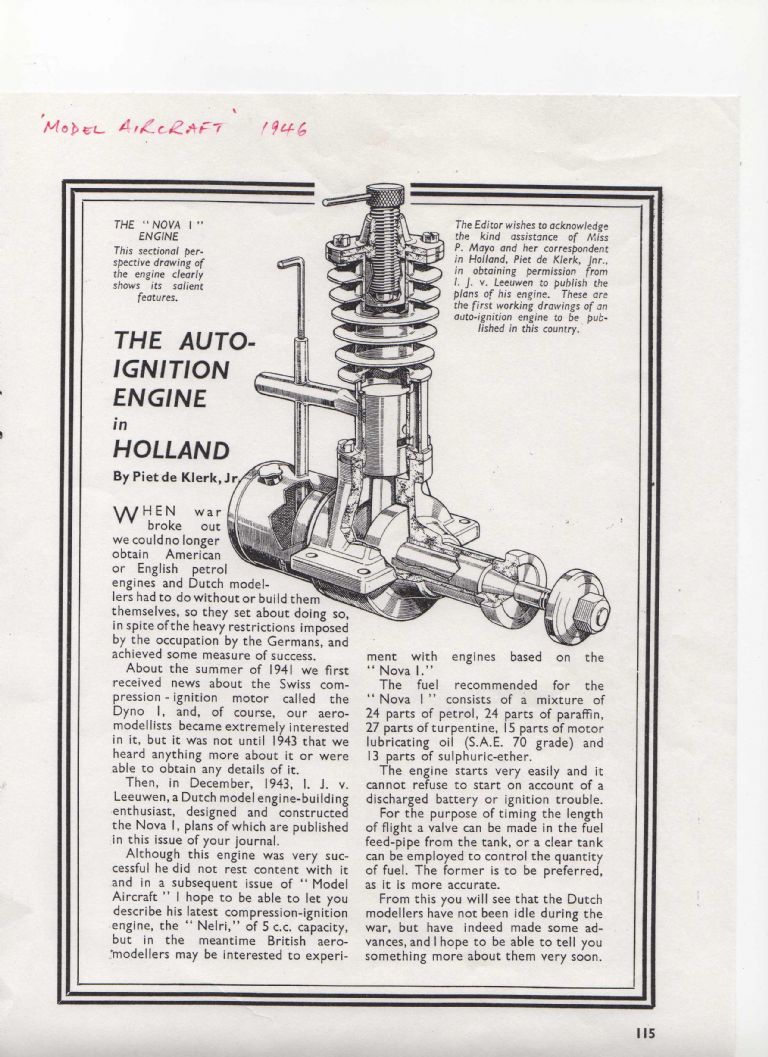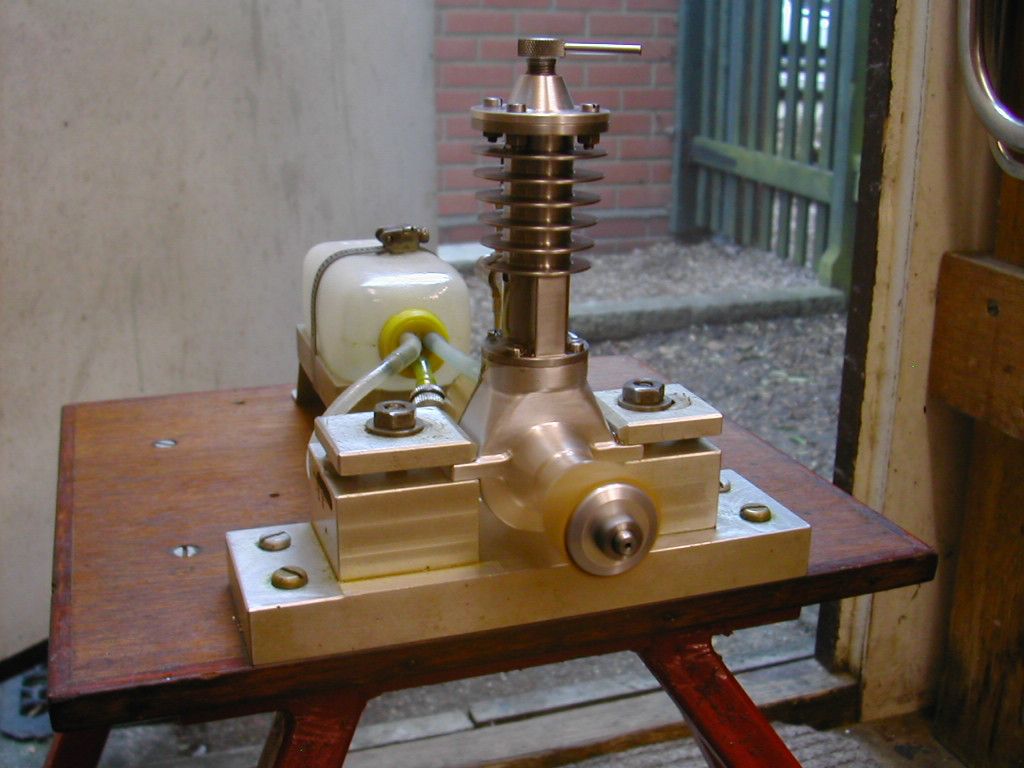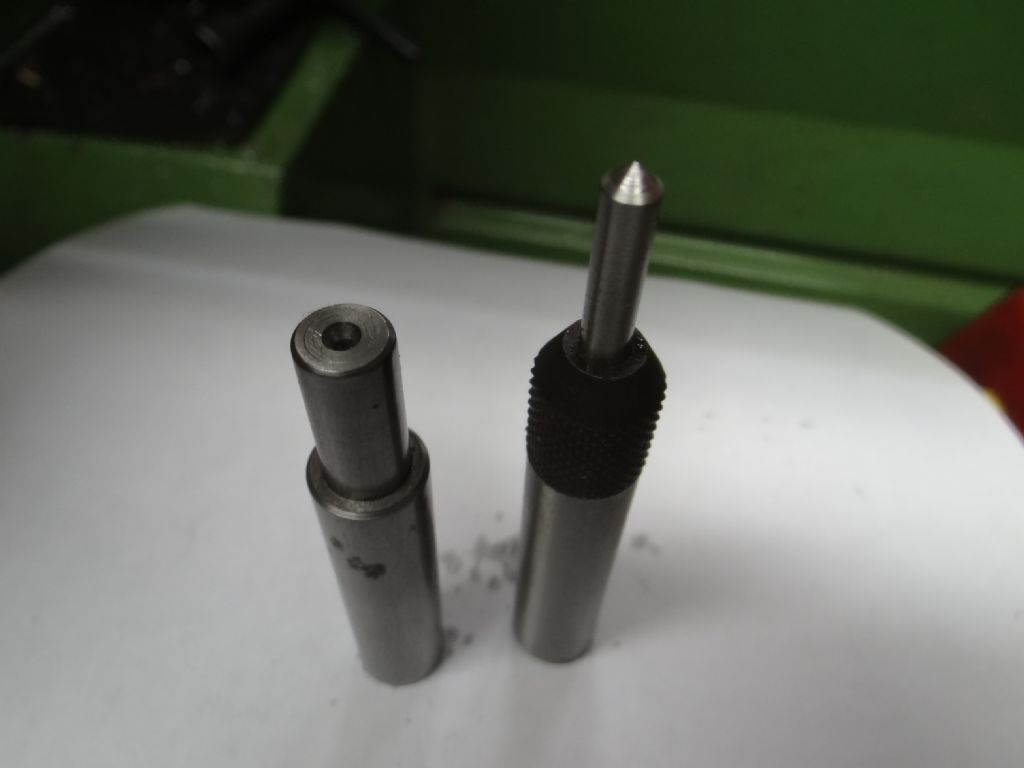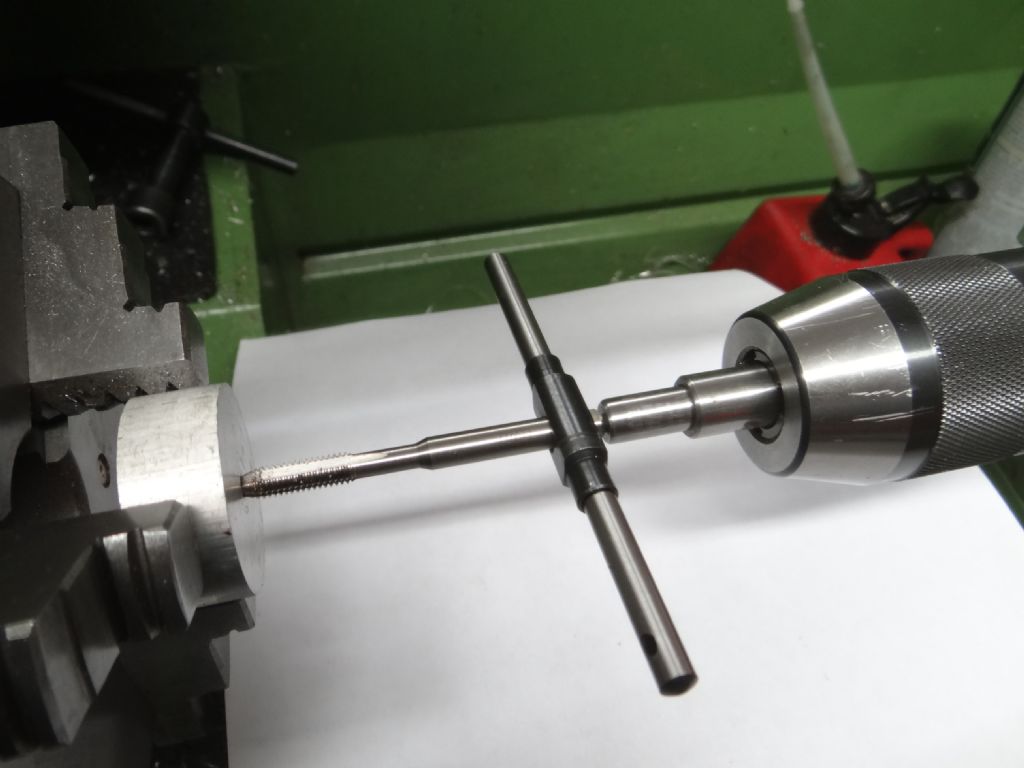Oh no - not another newbie!
An aeromodeller goes metal....
| Tim Hooper | 14/11/2022 22:51:12 |
10 forum posts | Hi all, I've been lurking here for a few weeks, so I guess it's time to say hello! I'm a time-served aeromodeller, who's heading towards retirement and has decided to take the plunge with some metal abuse. This isn't an impulse decision; over the last few months I've attended a short course at Shrewsbury College to learn the basic basics of turning and milling, as well as binge-watching YouTube videos from the likes of Blondihacks and Clough42. A few weeks ago I took the financial plunge and went shopping at Chester Hobby Stores, returning home with a V20 mill (since fitted with a DRO) and an 8x16 DB8 lathe. There's a also a drawer full of cutters, collets, parallels, etc. So what's the point? Well, eventually I'd like to produce a working model diesel engine or two (I've downloaded several sets of drawing from the Outerzone), but in the interim I'll attempt to produce replacement parts for my small collection vintage diesels. So that's the plan! In the meantime, I'll hang around here and pick the brains of the experts, if that's OK. Tim |
| Jon Lawes | 14/11/2022 22:55:11 |
1078 forum posts | Tim, sounds like you are heading into this eyes wide open. I sincerely hope you find as much pleasure in it as I have. |
| Steviegtr | 15/11/2022 01:42:58 |
2668 forum posts 352 photos | Welcome along Tim. Many accomplished engineers on this forum , that will give you plenty of help along your journey.
|
| SillyOldDuffer | 15/11/2022 09:15:43 |
| 10668 forum posts 2415 photos | Welcome to the forum Tim, in at the deep end with diesels! I found it useful to start the learning process by making a few simple tools, and - although I'm not a modeller - moving on via a couple of stationary steam engines (run on air), and a Stirling. I found Stewart Hart's PottyMill engine an excellent learner project because it's fabricated (no castings), and the build is neither too easy or too difficult. I used this rather cluttered plan, it's OK, no errors. Stewart's original is properly drawn on several sheets but I've lost the link. Later on I used the same engine to develop my CAD skills. Photos are always good if you have a camera, how to post them described here. Bit embarrassing but searching the web for PottyMill images finds a couple of my clunky pictures rather than any of the many much better built and finished versions made by other people!
Another hint, the forum's internal search top right isn't much cop. There's a better one, using Google, hidden away half way down the home page. Dave |
| Mike Hurley | 15/11/2022 10:06:10 |
| 530 forum posts 89 photos | Welcome Tim. Plenty of good friendly advice here!. As Dave suggests, perhaps don't try to run before you can walk, While training courses are a good grounding, nothing beats hands-on experience with your own machines / tools in your normal environment. Get the basics right first and everything else will follow. Practice on small projects first, try making a few add-ons for your new kit (plenty of plans/ideas on this forum or in books) make sure you can work to good accuracy from plans etc. Nothing more likely to dampen your enthusiasm than one failed project after another - Been there, done that, got the tee-shirt. Best of luck, Mike |
| noel shelley | 15/11/2022 10:58:38 |
| 2308 forum posts 33 photos | Welcome aboard shipmate ! You will find experts in almost every field on here who will gladly share their knowledge with you, Just ask ! You mention diesels what size ? 1 or 2 cc or are we talking MUCH bigger ? Good luck. Noel. |
| Tim Hooper | 16/11/2022 06:32:10 |
10 forum posts | Thanks for the warm welcome, gents! As a hacker of balsa wood, I'm too aware of my limitations as regards precision. I have to be closer than 1/16", right? Perhaps I should also mention that I'm a regular columnist in RCM&E magazine, where I'm logging my progress in model engineering as an adjunct to my usual aeromodelling adventures. I'm also very lucky in that not only do I have a very supportive spouse, but there's also two proper machinists in my local model flying club, who are both being very helpful with advice and scrap material to practice on. To be continued...... Tim
|
| Howard Lewis | 16/11/2022 07:00:27 |
| 7227 forum posts 21 photos | Welcome Tim! Shrewsbury is very fortunate to have a Technical College providing such courses.. You sound to be well set up already My advice is to gain more experience by making small tools. You will become familiar withe machines, and have items that you can use for years to come.. You can learn, ,by making mistakes, on relatively cheap material, rather than expensive castings! WAY back, I attended Shrewsbury Tech, when it was beside the English Bridge, and when it moved to what were then the outskirts. Howard |
| Ramon Wilson | 16/11/2022 08:19:34 |
1655 forum posts 617 photos | Welcome Tim from another life long aeromodeller - mainly control line and free flight with some R/C glider I've had many small engines over those years (sixty plus) but it was quite late when I decided to make my own. I do believe I covered the build on here somewhere and it was serialised in ME mag. Once that first attempt broke into a run I was hooked on making them for quite a while. I made all mine from scratch without using any castings so the latter is not something that is necessarily required. There are several other builds on Model Engine Maker too of my other projects if that's of interest. Biggest pitfall is to start with something too small in capacity - yes many have been made around the .8cc mark but getting the piston liner fit becomes more challenging the smaller you go. A good project to begin with would be the Nalon Viper -2.5cc diesel and as designed completely made from bar stock material. A good performer too if made well. There are several glow engines to choose from too as no doubt you have found but my preference are diesels As my interest in making engines comes to an end however it's good to hear of someone with a new interest in them so good luck with the start of your adventures with the delights of 'making your own' - if I can be of any help just ask. Best - Tug PS Here's the one that kicked it all off for me - The Nova 4.5cc BTW Ignore that fuel recommendation! Edited By Ramon Wilson on 16/11/2022 08:22:23 |
| Tim Hooper | 16/11/2022 21:40:35 |
10 forum posts | Again, thank you gents! Howard, I hear you on the making of tools as a learning process. It's obviously easier and cheaper to buy tools online these days, but that's not the point, is it? I did buckle and buy a knurling tool, but I'm already regretting it! Ramon, thanks for the engine advice! I'm looking at the 2.5cc Holly Buddy for an eventual project. There are no castings involved. I think the trick would be to treat each separate engine component as a mini project in its own right. In the meantime, I'm involved in some heavy duty decorating at home, so there won't be much movement in the workshop for a week or two.... Tim |
| Ramon Wilson | 16/11/2022 22:52:50 |
1655 forum posts 617 photos | Another good choice as a first off Tim and a good idea to treat each component as a separate task. I have posted quite a bit about my diesel engine builds from start to finish on the 'Model Engine Maker' and 'Home Model Engine Machinist' sites which you may find of use, one word searches of either Tiger, Tigre, Hunter, Eta should get you there if you feel so inclined. 'Domestic Interference' is a bane at any time when a model project calls so I empathise but do keep us informed once you begin that journey.
Tug |
| Howard Lewis | 18/11/2022 20:23:49 |
| 7227 forum posts 21 photos | Tim, You have a PM. Look for a flashing black envelope (In Box )at the top left of your screen Howard |
| Ramon Wilson | 19/11/2022 09:04:51 |
1655 forum posts 617 photos | Tim, further to my last reply and agreeing with the separate task approach - I should have added that I have always found it best to make each component to lead to the next - where the important fit of parts are required eg - case first, liner to fit case, cylinder head to fit liner, shaft to fit case etc May seem like stating the obvious but some do take the 'easy' parts to do first and that isn't always the best approach from a fit perspective. Besides if you haven't got a crankcase first you haven't got a start! If it's of interest there's also a detailed account on lapping a diesel piston to the liner on MEM Best - Tug |
| SillyOldDuffer | 19/11/2022 10:33:42 |
| 10668 forum posts 2415 photos | Posted by Tim Hooper on 16/11/2022 21:40:35:
... Howard, I hear you on the making of tools as a learning process. It's obviously easier and cheaper to buy tools online these days, but that's not the point, is it? I did buckle and buy a knurling tool, but I'm already regretting it! ...No need to be pure about making tools rather than buying them! One reason is as a training exercise. Make something at the L-plate stage that works instead of taking lots of boring experimental cuts. Experimental cuts are necessary - whilst a lathe works to about 0.02mm, the operator only becomes a machinist after learning enough about cutting tools, how various metals behave, and the effects of rpm, depth of feed, and feed-rate. There's a lot to learn, almost endless, if best results are needed. Not only taking cuts, but planning their sequence (often tricky), and how to read drawings. Hopeful hacking works to a degree, but it's much better to develop skills. Another is the common need in metalwork to make tools to get the job done, and to make new tools from scratch. Fixtures, jigs, punches, form-tools, you name it. The lathe is called the Queen of machine tools for good reason! It's the tool par-excellence for making other tools. This is quite unlike woodwork, where saws, chisels, screwdrivers, nails and nuts and bolts all have to be bought in. A screw-cutting metal lathe can make nuts and bolts, jolly useful for specials, but I buy nuts and bolts in bags! Some examples: 1. A home-made ER chuck spanner for my mill. Rather than buy a spanner for the mill when it and I were new friends, I made one. The head was milled from mild-steel, the handle lathe turned, drilled, tapped and knurled on the lathe, apart from the cheeks which were milled. Although the spanner is simple, several techniques had to mastered to make it. Ideally, I should have gone a step further and learned how to case-harden the jaws, but it works well enough. Next, a female tap holder. Males like the one on the right are easy to buy so I did. But I couldn't source a female, so I made one. The body is bored out to take a spring loaded head, with a pinned base to stop the innards ejecting. All done on the lathe, but a Tap holders are used in a set-up like this, their important purpose is to hold a screw-cutting tap at 90° to the hole. Misery ensues if a tap goes in askew, and tapping without mechanical help is too easy to get wrong. Lastly, this strange beast. It was made to support a long brass pin so that half the diameter of the shaft could be milled off. I remember holding the pin in the steel block with a dab of super-glue for cutting, but not what the pin was for! Odd tools like this often turn up in deceased workshop sales, and no-one knows what they're for. Punches are a good place to start. The point faced off flat and turned to an accurate diameter, then the handle optionally knurled, number-stamped, polished, and otherwise beautified. If made in silver steel, hardened and tempered too. Getting the first one right and going the full monty on finish could take a beginner a few days, but once the skills are obtained they, and similar objects, can be quickly knocked out. Making real things is a good way of establishing how effective the operator and his machines are. Many lathe shortcomings, such as worn second-hand or poorly finished new hobby machines, can be circumvented by a skilled operator. Individuals vary too. I'm forgetful and clumsy, others seem to have be born with a magic touch. I've found the forum invaluable - more so than internet videos, many of which contain inadvertent bad practice. Watch them with your critical filter set to 11! The forum is better because people correct misleading posts and offer alternatives. Dave |
| noel shelley | 19/11/2022 10:52:29 |
| 2308 forum posts 33 photos | Dave mentioned making punches ! As an engineer working in agriculture I came across web links as used on sugar beet lifters, on a 3 row machine about 4' long. there would be 2 straight sections that would be cut out about 15" long with a grinder ! The material was chilled steel and about 1/2" dia, even carbite struggled to cut it but it made wonderful punches. I still have and use the ones I made 40 years ago. But DO NOT try to knurl, it will ruin the wheels. If one is in the beet growing area and asks around at farms you may be lucky to get some. Noel. |
Please login to post a reply.
Want the latest issue of Model Engineer or Model Engineers' Workshop? Use our magazine locator links to find your nearest stockist!
Sign up to our newsletter and get a free digital issue.
You can unsubscribe at anytime. View our privacy policy at www.mortons.co.uk/privacy
- *Oct 2023: FORUM MIGRATION TIMELINE*
05/10/2023 07:57:11 - Making ER11 collet chuck
05/10/2023 07:56:24 - What did you do today? 2023
05/10/2023 07:25:01 - Orrery
05/10/2023 06:00:41 - Wera hand-tools
05/10/2023 05:47:07 - New member
05/10/2023 04:40:11 - Problems with external pot on at1 vfd
05/10/2023 00:06:32 - Drain plug
04/10/2023 23:36:17 - digi phase converter for 10 machines.....
04/10/2023 23:13:48 - Winter Storage Of Locomotives
04/10/2023 21:02:11 - More Latest Posts...
- View All Topics
- Reeves** - Rebuilt Royal Scot by Martin Evans
by John Broughton
£300.00 - BRITANNIA 5" GAUGE James Perrier
by Jon Seabright 1
£2,500.00 - Drill Grinder - for restoration
by Nigel Graham 2
£0.00 - WARCO WM18 MILLING MACHINE
by Alex Chudley
£1,200.00 - MYFORD SUPER 7 LATHE
by Alex Chudley
£2,000.00 - More "For Sale" Ads...
- D1-3 backplate
by Michael Horley
Price Not Specified - fixed steady for a Colchester bantam mark1 800
by George Jervis
Price Not Specified - lbsc pansy
by JACK SIDEBOTHAM
Price Not Specified - Pratt Burnerd multifit chuck key.
by Tim Riome
Price Not Specified - BANDSAW BLADE WELDER
by HUGH
Price Not Specified - More "Wanted" Ads...
Do you want to contact the Model Engineer and Model Engineers' Workshop team?
You can contact us by phone, mail or email about the magazines including becoming a contributor, submitting reader's letters or making queries about articles. You can also get in touch about this website, advertising or other general issues.
Click THIS LINK for full contact details.
For subscription issues please see THIS LINK.
Model Engineer Magazine
- Percival Marshall
- M.E. History
- LittleLEC
- M.E. Clock
ME Workshop
- An Adcock
- & Shipley
- Horizontal
- Mill
Subscribe Now
- Great savings
- Delivered to your door
Pre-order your copy!
- Delivered to your doorstep!
- Free UK delivery!


















 Register
Register Log-in
Log-in


